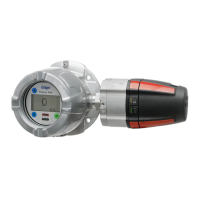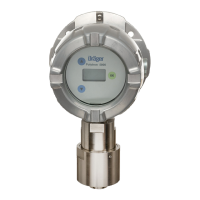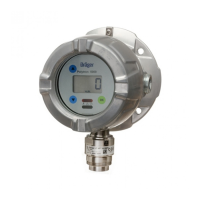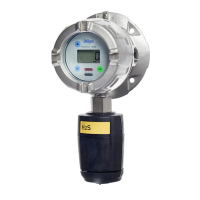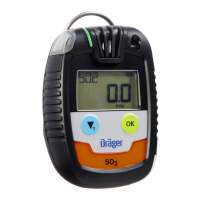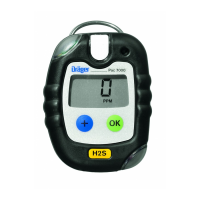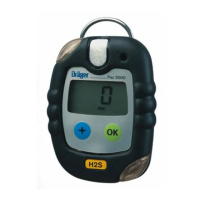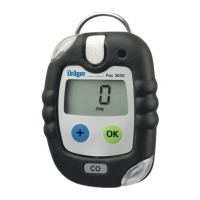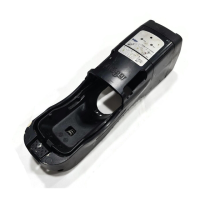18 Dräger Polytron 8700/8720
Settings menu
8 Settings menu
This menu contains all the functions that are required for the
individual configuration of the device.
8.1 Switching SIL lock on or off
With this function, the device can be protected against
unauthorized changes to the configuration with a password.
Changing the configuration (e.g., changing the measurement
range from 100 %LEL to 50 %LEL) will cause the device to
display all the safety-relevant parameters to the user once
more before it returns to the measurement mode. The
correctness of the parameters and settings must be confirmed.
1. Select Settings > Instrument > Set SIL.
2. Select the desired state On or Off and confirm.
8.2 Device settings
8.2.1 Alarm settings (only with installed relay module)
Alarms issued via relays and LEDs.
Switching the alarm on or off
1. Select Settings > Instrument > Alarm > Alarm on/off.
2. Select the desired state On or Off and confirm.
Configuring Relay A1 or A2
This function is used to define whether the alarm relay is
energized in standard operation or in an alarm state. If the
configuration of the relay is set to "Normally energized", the
corresponding relay contact is closed in the normal case and
drops out in the event of an alarm. This configuration results in
an alarm being triggered in the event of a loss of power to the
transmitter (fail-safe). The fault relay is factory-configured to
"Normally energized" and cannot be changed.
1. Select Settings > Instrument > Alarm > Relay A1 or
Relay A2 and confirm.
2. Select Normal energy supply oder Energy supply
during alarm and confirm.
Configuring Alarm A1 or A2
1. Select Settings > Instrument > Alarm > Alarm A1 or
Alarm A2 and confirm.
2. Select the line for entering the alarm limit and confirm.
3. Set the threshold and confirm.
The setting for the alarm threshold is displayed.
4. Select Next and confirm.
The setting for the alarm direction is displayed.
5. Select Rising or Falling and confirm.
6. Select Next and confirm.
The setting for the alarm direction is displayed.
7. Select Latching or Non Latching and confirm.
8. Select Next and confirm.
The setting for the acknowledgement is displayed.
9. Select Acknowledgeable or NonAcknowledgeabl or
PreAcknowledgeabl and confirm.
10. Select Next and confirm.
The functional relationship between the various settings is
explained in the following table:
NOTICE
SIL lock is only available for certain sensors (see also
the sensor data sheets or the Dräger Polytron 8X00
Safety Manual).
NOTICE
When SIL is activated, the device displays all the
important parameters and setting before returning to
measurement mode. Check the parameters and
settings carefully and confirm.
CAUTION
In the normal state, the relays in the relay module are
energized. That is, the relays change their state if the
power supply is interrupted!
CAUTION
If the alarm is inactive, the alarm state will not be
issued by the LEDs or the relay interface! A warning
message will be shown on the display!
i
i
i
i
!
!
Latching and
acknowledgeable
The alarm must be acknowledged
manually. The alarm can be
acknowledged when the alarm
condition is still present.
Latching and not
acknowledgeable
The alarm must be acknowledged
manually. The alarm can only be
acknowledged when the alarm
condition is no longer present.
Latching and pre-
acknowledgeable
The alarm must be acknowledged
manually. The alarm can be
acknowledged when the alarm
condition is still present but will only
be reset when the alarm condition is
no longer present.
Non-latching and
acknowledgeable
The alarm is acknowledged
automatically when there is no longer
any alarm condition present, or it can
be acknowledged manually.
Non-latching and not
acknowledgeable
The alarm is acknowledged
automatically when there is no longer
any alarm condition present.
The alarm cannot be acknowledged
manually.
Non-latching and pre-
acknowledgeable
Corresponds to the alarm behavior
for "Non-latching" and "Not
acknowledgeable".

